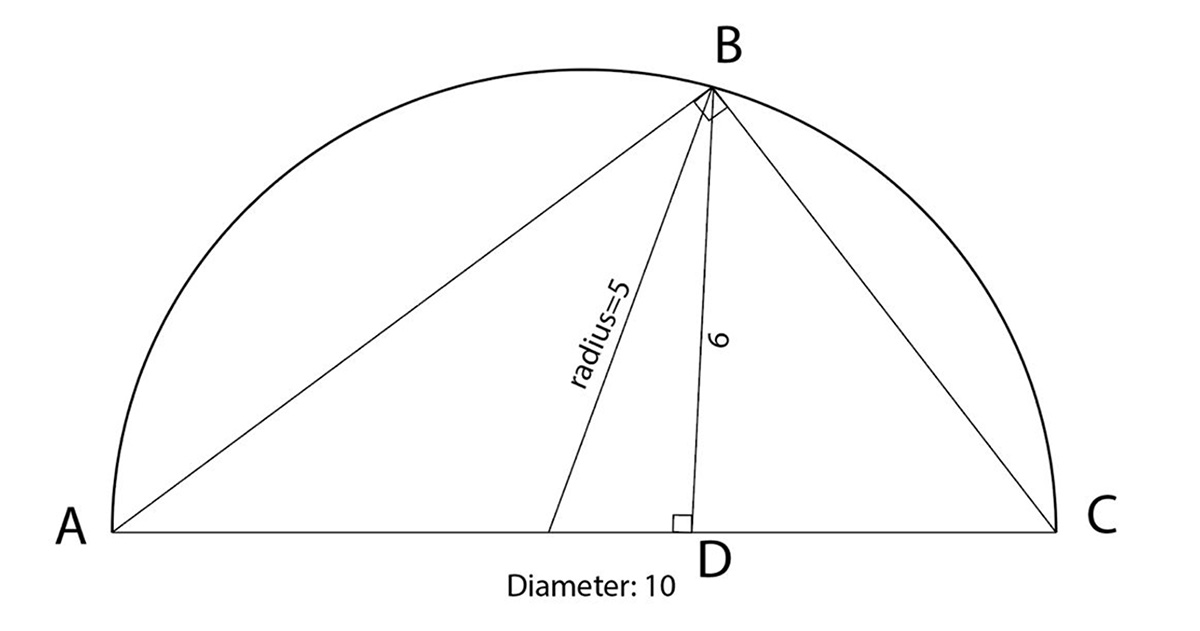Ronald Reagan once said "Trust but Verify" when dealing with the Soviet Union. Little did he know, he was describing the secret of Russian mathematics education. Let me tell you a story about a simple triangle problem that stumped American students. It managed to fool artificial intelligence, confuse parents, and even got past Wikipedia and YouTube. But students who had learned Russian Math? They immediately knew something was wrong. Here's the problem a teacher gave to a classroom. In the classroom, there were three children who studied Russian Math and others who weren't: "Right triangle ABC has base AC length 10. Angle B is 90 degrees. Height BD is 6. What is the area?" Simple, right? A student who hadn't learned Russian Math quickly raised his hand and said -- "30." The three children studying Russian Math started laughing. The other student was confused: What's so funny? The teacher jumped in: Children, don't laugh. 30 is correct! The three children studying Russian Math laughed even harder. The student was determined to prove he was right. He went home and asked ChatGPT: What's the area? ChatGPT said: "30." He asked his parents. They got out their calculators: "30." He looked up triangle formulas on Wikipedia, watched YouTube videos, checked math textbook after math textbook. Every single source said the same thing: Area equals one-half base times height. The answer is 30. The next day, he came back to school with absolute confidence. The answer is definitely 30. I checked everywhere! The three children studying Russian Math burst into laughter again. This is where Reagan's wisdom comes in. Everyone trusted the formula. The student trusted the numbers he was given. But nobody verified whether the problem actually made sense. The three children studying Russian Math had been taught to trust mathematics, but always verify the setup. And when they verified this problem, they discovered something shocking... The problem is mathematically impossible to solve. Let me show you what the students who had learned Russian Math immediately recognized. When you have a right triangle, you can always draw a circle around it with the hypotenuse as the diameter. This is a fundamental geometric principle: - Thales' theorem. Since AC is 10, the radius of this circle is 5. Now here's the problem: Point B must lie ON this circle. But we're told the height BD is 6. Look what happens when I draw the height. It creates a right triangle where BD is 6, but the radius - which is the hypotenuse - is only 5.
I used the formula: one-half times base times height. One-half times 10 times 6 equals 30.
Wait a minute. In any right triangle, the hypotenuse must be the longest side. But here we're saying a leg of 6 is longer than the hypotenuse of 5.
That's geometrically impossible!
The three children studying Russian Math weren't laughing at the answer 30. They were laughing because everyone was trying to solve a problem that couldn't exist in real geometry.
Now you might be thinking - when will my child ever need to verify impossible triangle problems?
But here's the thing - this happens every single day. People trusted financial advisors who promised impossible returns and lost their savings in 2008. Investors trusted Theranos without verifying if their claims were scientifically possible. Every day, people trust AI, trust experts, trust formulas - without asking the simple question those three Russian Math students asked:
Does this actually make sense?
The 2008 financial crisis happened because people trusted mortgage formulas without verifying if housing prices could rise forever. Theranos fooled investors because people trusted claims without verifying if tiny blood samples could run hundreds of tests. ChatGPT confidently gives wrong answers because it trusts patterns in data without verifying logical consistency.
This is the difference between traditional math education and Russian Math.

| Private Lessons | | | Group Lessons |
Traditional approach: Trust the formula, plug in the numbers, get an answer. Never question whether the problem makes sense.
Russian Math approach: Trust but verify. Yes, use the formulas, but first verify that the problem is mathematically sound.
Reagan was talking about nuclear treaties, but he could have been describing mathematics education: Trust the process, but always verify the assumptions.
We're not just teaching math. We're teaching the most valuable skill in the information age - the ability to think critically and verify what you're told, no matter how confident the source sounds.
Russian Math teaches kids to be like those three students - to pause, think, and ask "Does this actually make sense?" before accepting any answer, no matter how authoritative the source.
This kind of critical thinking is why students learning Russian Math consistently outperform their peers. It's why over 1.4 million students who've learned through our Build Your Own Math program excel in competitions and get into top universities.
It's why the Wall Street Journal, London Times, and New York Post have featured Russian Math as the approach that develops real mathematical thinking.
We're not just teaching formulas. We're teaching Reagan's principle: Trust but verify. Question assumptions. Think critically. Understand deeply.
Don't let your child become a formula-memorizer who gets fooled by impossible problems - whether in math class or in life. Teach them to think like those Russian Math students - to trust mathematics but verify everything.
Click the link to download our free Russian Math workbooks and see the difference for yourself. Or book a free trial session where your child can experience this kind of deep mathematical thinking.
Because in a world full of information, the most valuable skill isn't memorizing formulas - it's knowing how to verify what's true.
Remember: Trust but verify. That's not just good foreign policy - it's great mathematics education.

| Private Lessons | | | Group Lessons |